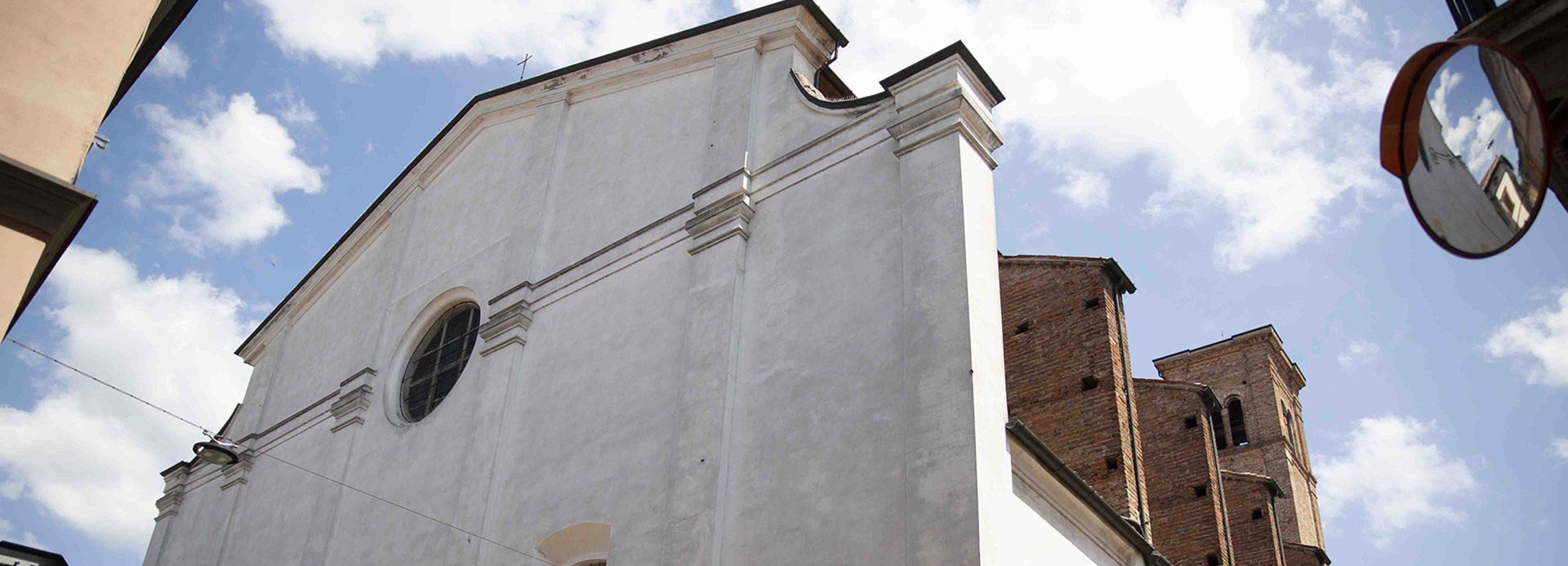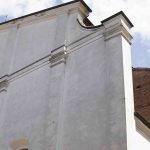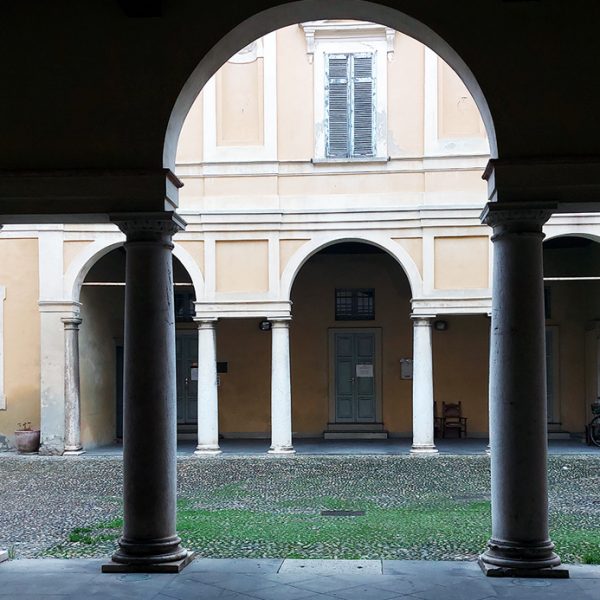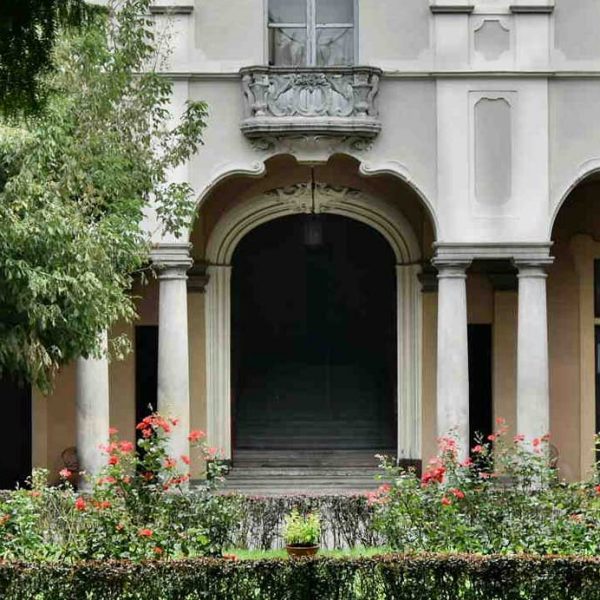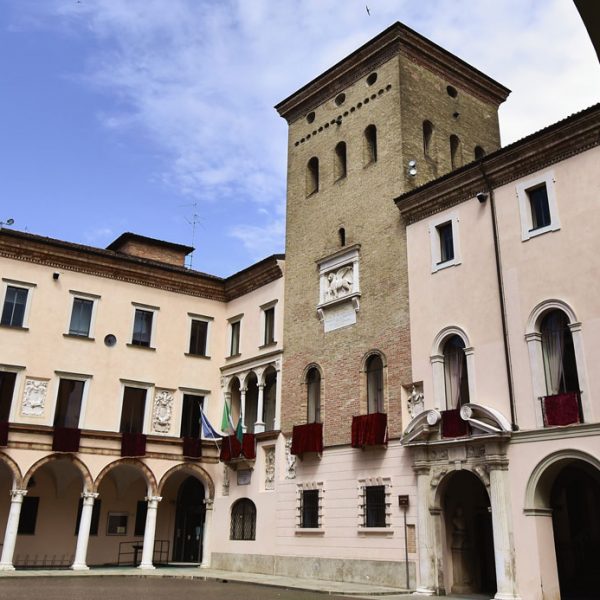 Tutti i luoghi
Tutti i luoghi
The edification of St. Bernardino in Crema began in 1518 to accommodate the community of observant Franciscan friars, also called the “zoccolanti”. Four years earlier, in 1514, Renzo da Ceri who commanded the defense of Crema against the imperial and Sforza troops had been forced to destroy the monastery of St. Bernardino outside the walls because the enemies could hide there. The friars had therefore withdrawn to the city and were waiting for a new seat.
The building was completed in 1534 and the official consecration took place on April 6, 1579.
In 1810 the monastery was suppressed by the Napoleonic laws and the church became a subsidiary of the Cathedral. This prevented it from being destroyed and its works of art from being dispersed as it happened for other churches in Cremona.
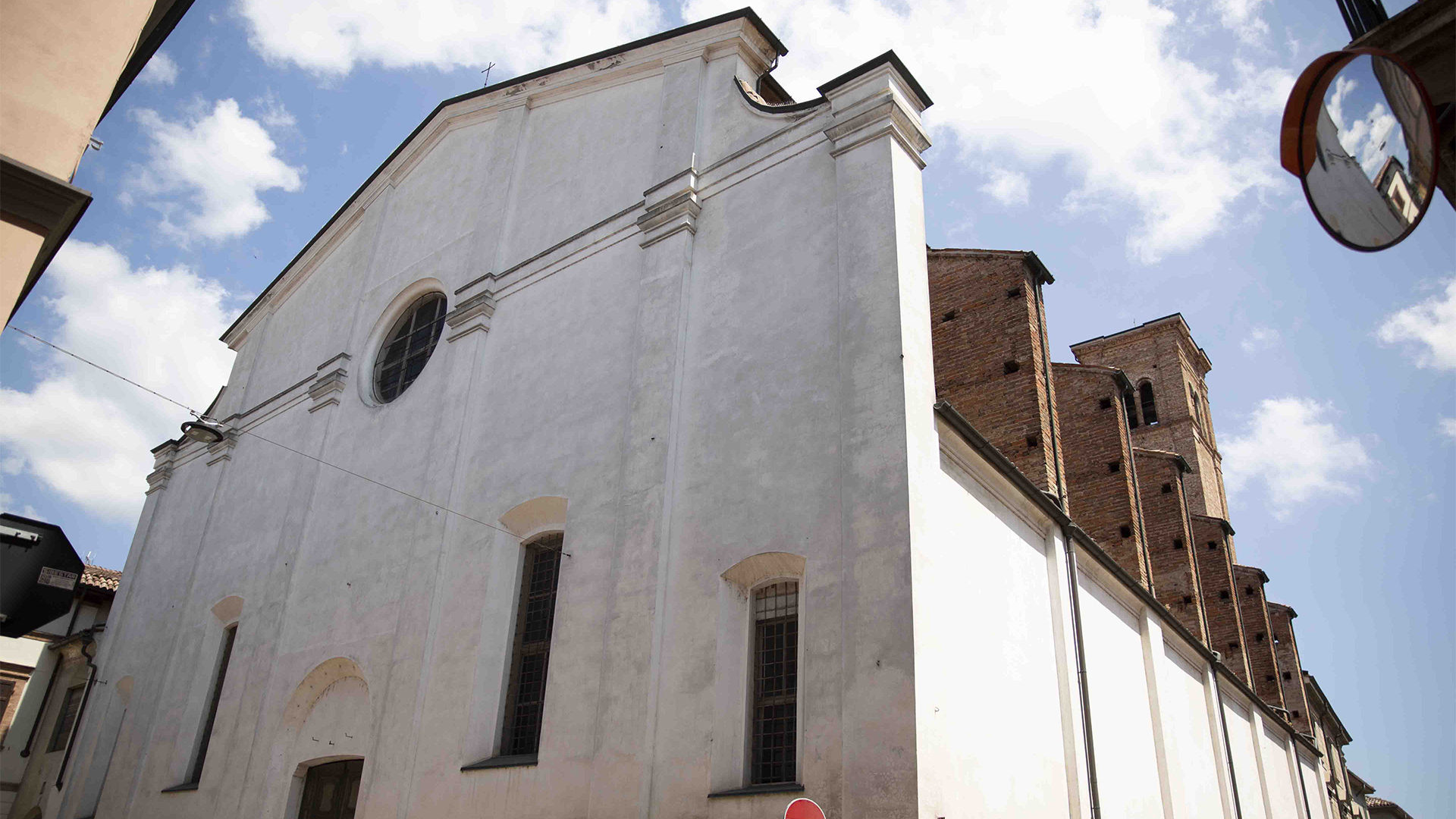
In 1868-69 the sacred building was restored to a design by engineer Carlo Donati de ‘Conti and engineer Luigi Re. On this occasion the ceiling of the vault was decorated by the Cremasco scenographer Luigi Manini (Crema, 1848 – Brescia, 1936) , who also remade the large fresco of the Annunciation which is located above the triumphal arch, leaving only the hands and faces of the original sixteenth-century work of the Cremasco painter Vincenzo Civerchio (Crema, circa 1470 – circa 1544).
The church was restored again between 1994 and 1996 on a project by the Ermentini architects and in the following years the individual chapels were restored.
After the important interventions at the end of the twentieth century, the church, next to its never-failing liturgical destination, was also used as an auditorium dedicated to the memory of Dr. Bruno Manenti, patron of Cremas. Classical music concerts, conferences and exhibitions take place in it.
This church can be considered as a real gallery of Cremasque painting: in fact, here there are works both original and from other suppressed churches, by all the most important Cremaschi artists from the sixteenth to the nineteenth century.
It is a Renaissance-style building with a large single hall that lent itself well to the needs of an order such as the Franciscans whose mission was to preach to the people.
Along the walls of the church there are six chapels on each side plus two on the sides of the high altar. On the pilasters that separate them on the occasion of the triduum of the dead – three days of prayer that were celebrated before carnival – canvases depicting skeletons dressed to represent all social strata were hung. These paintings are now kept in the Civic Museum of Crema and Cremasco.
Watch the video about the eighteenth-century skeletons of the church of San Bernardino in the city.

Let’s visit the church starting from the first chapel, entering on the left and proceeding anticlockwise.
Chapel of Sant’Eligio
The altarpiece above the altar, depicting Saint Eligius, is the work of the Cremasque painter Gian Giacomo Barbelli (Offanengo, 1604 – Calcinato, 1656) who made it in 1639 as you can read in the cartouche at the bottom right. On the sides of the entrance to the chapel there are six small canvases from the early eighteenth century, the work of the Veronese painter Giovanni Brunelli (Verona, 1644/46 – Crema, 1722). Starting from the top left, they represent: Saint Eligius consecrated bishop, Saint Eligius bishop frees a possessed person, Saint Eligius helps the poor.
On the right side, from above: Saint Eligius frees an innocent person condemned to hang, Saint Eligius assists a paralytic, Saint Eligius bishop frees a possessed woman.
The chapel was under the patronage of the blacksmiths’ fraglia of which Saint Eligius, as well as the goldsmiths and farriers, was the protector.

Chapel of the Perdono d’Assisi
In the sixteenth century this chapel was dedicated to the Twelve Apostles. In 1759 it changed dedication by request of the noble Pio Benvenuti and with the approval of Bishop Marcantonio Lombardi, to be entrusted to the “Consorzio del Perdono d’Assisi”. The altarpiece today is the work of the Cremasque painter Mauro Picenardi (Crema, 1735 – Bergamo, 1809) and was executed in 1788. On the left wall hangs a canvas depicting the Madonna and Child, Saint Andrew presenting the donor and Saint Antonio Abate. The author of this painting is unknown, nor is it known in which chapel he was originally located; instead, the date of execution is written: 1601. On the right wall hangs a painting depicting the Immaculate Conception recognizable by the presence of various iconographic attributes such as the moon under her feet, the crown of twelve stars above her head, the seven-headed dragon. The painting, which can be traced back to the end of the sixteenth century, is attributed to the painter Tommaso Pombioli (Crema, about 1579 – 1636) and its original location is unknown.
Chapel of San Pietro in vincoli
Originally it was dedicated to St. Francis, later to the Japanese martyrs and finally in 1675 it became the patronage of the
guild of merchants that dedicated it to San Pietro in Vincoli. For the occasion the altarpiece that still stands on the altar was commissioned to the Cremasque painter Giovan Battista Lucini (Vaiano Cremasco, 1639 – Crema 1686). It depicts an angel who frees the apostle Peter from prison.
On the left wall hangs a late 16th century canvas depicting the Vocation of Saint Andrew, a work signed by the Brescia painter Pietro Marone (Brescia, 1548 – 1603). The provenance of this painting is unknown.
On the right wall there is a painting with the Crucifixion and a donor work from the end of the sixteenth century attributed to the Cremonese painter Aurelio Gatti (Cremona, 1556 – Piacenza, 1602). Perhaps this painting was originally located in the fifth chapel on the right which is dedicated to the Holy Crucifix.
Chapel of Angeli Custodi
The chapel was originally dedicated to St. Peter. During the seventeenth century it was granted in patronage to the “Consorzio degli Angeli Custodi”. In 1608 Pope Paul V extended their cult to the universal church and in 1670 Pope Clement X fixed the feast on 2 October. The Consorzio commissioned the decoration to the painter Tommaso Pombioli (Crema, about 1579 – 1636) who at the beginning of the seventeenth century created the four canvases and frescoes on the vault. From left to top we find: the Angel asks Gideon to destroy the altar of Baal and Hagar and the Angel. Above right: the Angel frees Saint Peter from prison and the Angel destroys the army of the Assyrian king Sennacherib. In the vault on the left the Angel inspires the prophet Habakkuk and on the right an Angel throws a demon into Hell. On the altar there is an eighteenth-century wooden statue depicting the Guardian Angel.
Chapel of Santissimo Crocifisso
In the sixteenth century it was under the patronage of the Vimercati family, while in the nineteenth century it was taken over by the”Consorzio degli Agonizzanti” coming from the suppressed church of Saint Caterina. From this also come the seventeenth-century wooden crucifix and the two statues of the Madonna and Saint Giovanni, perhaps from the sixteenth century.
It is likely that the ancient altarpiece with the Crucifixion – later removed to place the statue – is the one now located in the third chapel on the right.
The walls and the vault are decorated with early 17th century frescoes by Tommaso Pombioli (Crema, around 1579 – 1636). On the left Jonah vomited by the sea monster and on the right the Sacrifice of Isaac. In the vault inside the ovals, scenes from the Passion of Christ are observed: the Kiss of Judas, the Crowning with thorns, the Fall during the ascent to Calvary and Jesus stripped of his garments.
Chapel of Terz’ordine
Originally the chapel was dedicated to Saints Francis and Jerome. In 1904 the altar was destroyed to open a side door and the altarpiece by Stefano de Alberis (documented in Crema in 1546) was removed, now preserved in the Civic Museum of Crema and Cremasco.
The chapel was administered by the Franciscan tertiaries, that is, by the members of an association of lay people who lived according to certain rules inspired by the Franciscan life.
The frescoes on the vault and walls are the work of the Cremasque painter Gian Giacomo Barbelli (Offanengo, 1604 – Calcinato, 1656) and his workshop and date back to the mid-seventeenth century.
Above the door we find the Apparition of Christ and the Madonna to St. Francis. On the sides, on the left: the Blessed Margherita and Santa Elisabetta, the Roman empress. Right: Blessed Joan and Saint Elizabeth of Hungary.
On the left wall, St. Francis frees souls from Purgatory. On the top right wall: the Temptation of St. Francis and the Apparition of the Madonna and Child to St. Francis.
In the left intrados, starting from the top we find: St. Leo, St. Corrado and Blessed Tommaso. Under the arch: St. Ivo, St. Ludovico, St. Eleazzaro and St.Rocco.
In the right intrados, from above: St. Richard, St. Peter and Sant’Omobono.
Chapel of San Pasquale Baylon e San Giovanni da Capestrano
It was originally dedicated to the Seven Franciscan martyrs. At the beginning of the eighteenth century the Bondenti family took over the patronage of the chapel and dedicated it to Saints Giovanni da Capestrano and Pasquale Baylon, both canonized in 1690.
The altarpiece above the altar is the work of the Veronese painter Martino Cignaroli (Verona, around 1649 – Turin, 1726). It depicts the Apparition of the Immaculate Conception to St. John of Capestrano holding a crucifix and a banner, while the Eucharist appears at San Pasquale Baylon.
The frescoes in the chapel are the work of Giovanni Galliari (+1722) who painted them around 1703. On the left wall is depicted Saint Giovanni da Capestrano offering a cup to the Madonna, while on the left side is depicted San Pasquale Baylon in adoration of the eucharist elevated in another room.
Presbytery and choir
On the side walls there are two large canvases, coming from the Cathedral of Crema, where there are still today other paintings of the same cycle dedicated to Eucharistic miracles. They were built around 1680 by Giovanni Battista Lucini (Vaiano Cremasco, 1639 – Crema 1686) from Cremona. On the left we see the Miracle of Valencia depicted, on the right the Miracle of Turin.
On the right side of the choir there is the Last Supper signed by the Cremasque painter Giovanni Angelo Ferrario (Crema, about 1581 – 1636) and dated 1621. During the last restoration, on the left side of the choir two fragments of frescoes were found depicting Bishops datable to the second-third decade of the sixteenth century.
Noteworthy is the large organ, located in the center of the apse. Built in 1580 by Costanzo Antegnati, it was remodeled in the second half of the eighteenth century, as the neoclassical case denotes, and again in 1884 by Pacifico Inzoli. The last restoration dates back to 1994 by the Tamburini Factory in Crema.

Chapel of San Filippo Neri
The chapel from the eighteenth century was dedicated to St. Filippo Neri, while it was originally dedicated to St. John. The altarpiece depicts St. Filippo Neri adoring the Madonna and is a copy, by an unknown author, of the painting by Guido Reni made in Rome in 1614.
Chapel of Santi Bernardino da Feltre e Pietro d’Alcántara
The chapel is dedicated to Saints Bernardino da Feltre and Pietro d’Alcántara. The two saints are the protagonists of the beautiful altarpiece by Giovanni Battista Lucini (Vaiano Cremasco, 1639 – Crema 1686), where they are portrayed in adoration of the cross, surrounded by various angels holding a scroll where it is remembered how St. Bernardino of Feltre was the founder of the Monti di Pietà.
On the left wall there is another canvas by Lucini, depicting Saint Rosa da Lima with the Child, from the church of St. Dominic, now used as a city theater. On the right you can see an interesting altarpiece showing Saint Margherita da Cortona with two Franciscan saints, by an unknown eighteenth-century artist.
Chapel of Sant’Antonio da Padova
The chapel was formerly dedicated to the Madonna. Now it goes by the name of Saint Anthony of Padua. It is one of the most sumptuous chapels in the church, with its rich set of stuccos and canvases dating back to the mid-seventeenth century. All the architectural structures are stucco, like the decorative parts, spread over all the walls. The author of the plastic part has left his signature and date on the pilasters at the entrance to the chapel: Antonio Prandi, 1651. The entire pictorial apparatus of the room also dates back to the same year, entirely created by Gian Giacomo Barbelli (Offanengo, 1604 – Calcinato, 1656). The paintings on canvas and the frescoed parts narrate the vicissitudes of the saint dedicatee. On the altar we see the altarpiece depicting Saint Anthony with the Child Jesus, a signed and dated work; on the left wall is the canvas entitled Saint Anthony heals a woman with his cord; on the right we have Saint Anthony healing the sick child. Other miraculous events are frescoed in the two lunettes at the base of the vault, where the graceful and elegant ones painted by Barbelli sit among the stucco angels. On the left is depicted the miracle worked in the death of Saint Anthony who resurrects a drowned child; on the right, instead, the famous episode of Saint Anthony who reattaches the leg of a young man.
Chapel of Immacolata Concezione
This chapel is now dedicated to the Virgin, on whose altar there is an eighteenth-century painted wooden statue representing the Immaculate Conception. The set of paintings on the walls, however, suggests a different cult. Originally dedicated to St. John the Baptist, the chapel passed in 1544 under the government of the Guild of the Weavers, who dedicated it to St. Mark. The canvases tell the story of the evangelist and were made in the mid-seventeenth century, with a look at the Venetian Renaissance, by Carlo Antonio Barbelli, son of the most talented Gian Giacomo. On the left we have Saint Marco preaching in Alexandria; on the right is represented the Capture of Saint Mark. At the top there are two other canvases in the lunettes: on the left is depicted Saint Peter dictating the Gospel to Mark; on the right, finally, the Martyrdom of St. Mark. On the altar there was a bronze statue depicting St. Mark made in the first decade of the seventeenth century by Girolamo Bonino, now lost.
Chapel of San Giuseppe
This chapel has undergone some changes of dedication, as shown by the coexistence of works with different iconographies. Originally dedicated to the Blessed Virgin, it was dedicated to Saint Eligius in the seventeenth century, while now it is dedicated to Saint Joseph, a cult transferred here in the nineteenth century. The chapel previously dedicated to the putative father of Jesus was the first on the right, now dedicated to Saint Eligius.
The altarpiece by Gian Giacomo Barbelli (Offanengo, 1604 – Calcinato, 1656) with St. Eligius was therefore placed in this chapel, in place of the nineteenth-century statue of St. Joseph. Inside the decorative apparatus created by Luigi Manini (Crema, 1848 – Brescia, 1936) in the nineteenth century, we see, on the left, the canvas depicting Saint Eligius distributing goods to the poor, on the right the Adoration of the Shepherds, both works by Giovanni Brunelli (Verona, 1644/46 – Crema, 1722), active in Crema between the seventeenth and eighteenth centuries. The second canvas was not part of the cycle of the chapel dedicated to the saint and its original provenance is unknown.
Chapel di San Diego d’Alcalà
The chapel was dedicated to the saint to whom the church is dedicated, St. Bernardino. From the end of the sixteenth century, however, St. Diego of Alcalà, a saint of the Observant order, originally from Spain and canonized in 1588, is celebrated here. The altarpiece is by Aurelio Gatti called Sojaro (Cremona, 1556 – Piacenza, 1602). The painting depicts the Madonna and Child appearing in San Diego surrounded by a host of saints. On the right is a canvas depicting the Annunciation by Tommaso Pombioli (Crema, about 1579 – 1636) from the early 1600s and of unknown provenance.
Chapel of San Bonaventura
The chapel is dedicated to St. Bonaventure and dominates the rich Baroque altar. Above it is placed the altarpiece depicting the Madonna and Child with St. Bonaventure and St. Francis, made by Tommaso Pombioli (Crema, about 1579 – 1636). In the chapel there is a relic, the skull of Saint Fermo, as evidenced by the initials placed above the tabernacle.
Counter-façade
The organ was originally not located in this church, but was in the counter-façade of the Cathedral of Crema. The instrument case and the choir loft were made by the carver Peranda di Caravaggio on behalf of the “Consorzio della Madonna della Misericordia” between 1639 and 1647. In 1729 the choir was rebuilt by Giovanni Bartolomeo and Giovanni Battista Savio who also carried out works on the sculptures of the case.
During the Napoleonic wars it was deprived of all internal components which were merged to make weapons. Now reduced to an empty and silent shell, between 1913 and 1916 on the occasion of the restoration of the facade of the Cathedral, it was removed and placed in the church of St. Bernardino.

Info
Via Cesare Battisti, 2
Hours subject to restrictions
Visits prohibited during religious celebretions

